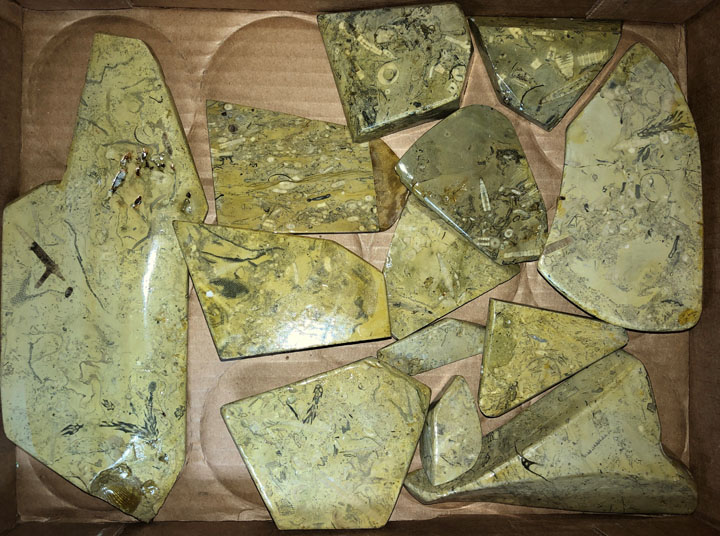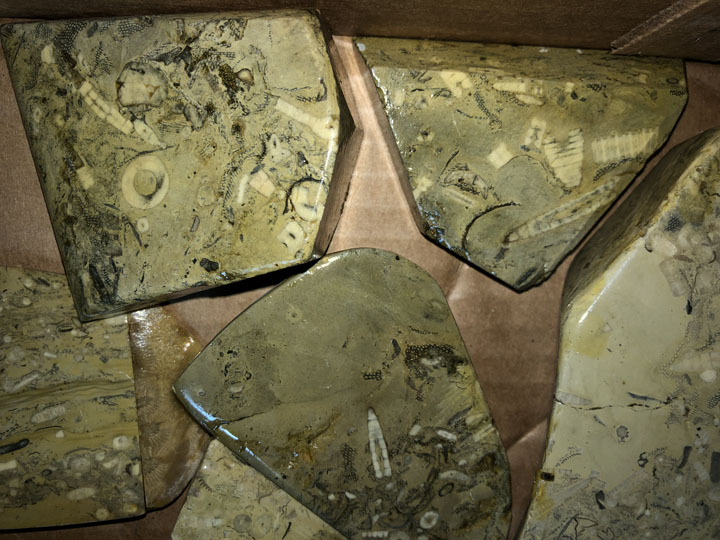|
|
Post by fernwood on Aug 21, 2021 17:01:51 GMT -5
Who does this and how do I undo it? Purchased some slabs (price was right) that were coated in lacquer (according to seller). He suggested soaking them in acetone to remove the lacquer. The slabs contain some great fossil critters/plants. What would you suggest to remove the lacquer? Lacquer thinner, acetone or something else? Thank you.      |
|
|
|
Post by rockjunquie on Aug 21, 2021 17:27:36 GMT -5
I would guess either acetone or lacquer thinner, but if you plan to cab them, just grind the coating off. Also, it could be something other than lacquer used to penetrate and stabilize. In that case, I don't know if you are getting it off.
|
|
|
|
Post by mohs on Aug 21, 2021 17:29:57 GMT -5
got yourself a nice section of fossil plates there Beth you already knew that maybe try some acetone on one of the less significant pieces but i wouldn't get to crazy Is the liquor yellowing ? O I used to do that  shellack rocks help them shine a bit on some small gravel rhyolite heart shape pieces that I stuck with velcro and handed out to my clients sorry but I was just a beginner ... |
|
|
|
Post by fernwood on Aug 21, 2021 17:55:44 GMT -5
Thanks.
I will try acetone, as I have some.
Coating does not appear to be yellowing. It is uneven in places, so I do not think it was anything to stabilize. But, I could be wrong.
|
|
|
|
Post by rockjunquie on Aug 21, 2021 18:03:33 GMT -5
Thanks. I will try acetone, as I have some. Coating does not appear to be yellowing. It is uneven in places, so I do not think it was anything to stabilize. But, I could be wrong. Uneveness would suggest to me that is did penetrate. |
|
|
|
Post by Pat on Aug 21, 2021 18:12:07 GMT -5
Use acetone from hardware store, not finger nail polish remover. Good luck.
|
|
rewdownunder
spending too much on rocks
 
Member since March 2012
Posts: 357
|
Post by rewdownunder on Aug 21, 2021 18:27:50 GMT -5
What do you think you are going to do with the material when you get the coating off? It may have been coated because the material will not take much of a shine (limestone?) You may want to grind on a piece a bit and see how deep the coating goes. In most cases you will never get all the coating and will not be happy with what it looks like. Please work outside as anything that will work on the coating will not be good to breath. Good luck let us know what you find
|
|
|
|
Post by fernwood on Aug 21, 2021 18:29:19 GMT -5
Yes, I have real acetone, not fingernail polish remover.
The coating looks like it was painted on, uneven. There are ripples/ridges in places.
Plan on giving one piece a soak on Monday.
|
|
|
|
Post by hummingbirdstones on Aug 21, 2021 18:43:22 GMT -5
These are pretty cool, Beth.
I know you probably know this, but make sure you do it outside where there is good ventilation so you're not breathing it in and make sure you cover your container so all the acetone doesn't evaporate away.
|
|
|
|
Post by Rockoonz on Aug 22, 2021 9:15:20 GMT -5
There are clear coating materials specifically for fossils, because they can often be crumbly and unstable. Since yours are slabbed sucessfully this is less likely, but proceed carefully. If you have a flat lap, or even sandpaper that will work wet on a flat surface, you might try that first. I have used the HF diamond knife sharpening blocks by hand to test unknown materials as well.
|
|
|
|
Post by fernwood on Aug 22, 2021 9:29:01 GMT -5
Thanks. I am going to soak the smallest piece in acetone first and see what happens.
|
|
quartzilla
Cave Dweller 
Member since April 2020
Posts: 1,240
|
Post by quartzilla on Aug 22, 2021 18:05:34 GMT -5
Sometimes the details in the fossils don’t show up well unless they are wet, or in this case, lacquered. I’d for sure pick a lesser one to soak. Good luck!
|
|